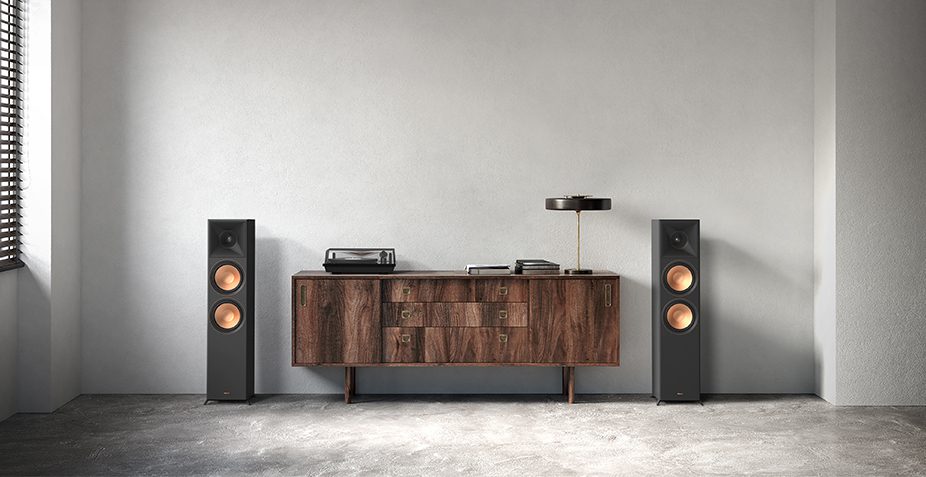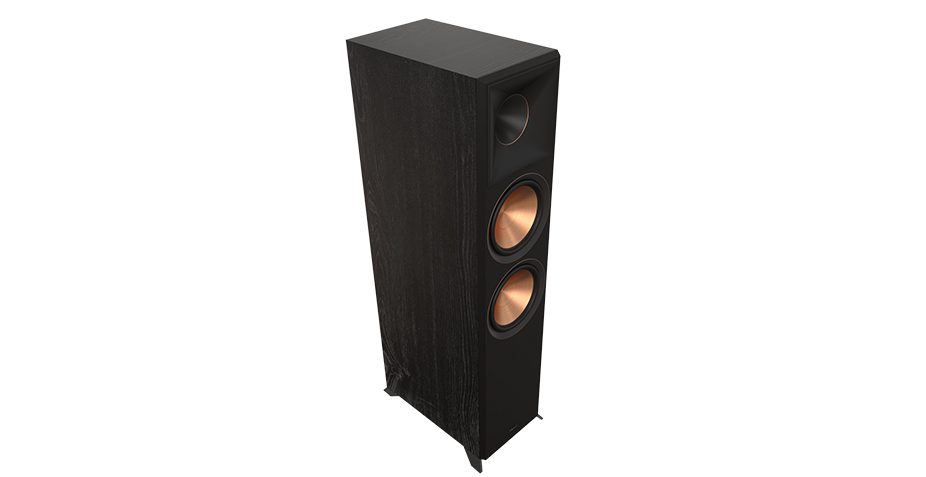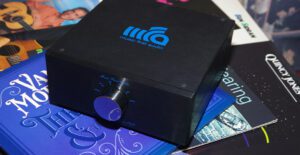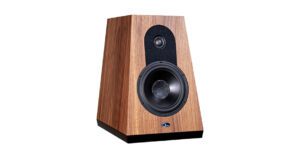
The Reference Premiere series of speakers from Klipsch may only have been introduced into the UK in 2019, and the RP-8000F II updated even more recently, but there lies behind them an impressive heritage that I will take the liberty of briefly outlining for those who are not familiar with the story.
Klipsch is one of those legendary brands that have carved out their place in audio history. Variously described as a genius, madman and maverick, Paul W Klipsch started it all by creating and building the iconic Klipschorn loudspeaker by hand in a tiny tin shed in Hope, Arkansas, in 1948. Such historic milestones always seem to take place in the humblest surroundings and it was in the cellar of his house in Ilkley in Yorkshire that another of the pioneers of loudspeaker design, Gilbert Briggs, made his first loudspeaker. He went on to found Wharfedale in 1932. These are just some of the legendary figures that helped get us where we are today.
Of course, while Wharfedale are credited with producing the first domestic two-way [moving coil] speaker cabinet with a crossover unit in 1947, it was horn-loaded loudspeakers for which Paul Klipsch is famous. He patented his design for the full-range Klipschorn corner horn in 1945, took on his first member of staff in 1948 and now the company’s Indianapolis factory employs more than 200 people and has a turnover of around $58 million.
Silver Medal
Paul Klipsch received a Silver Medal Award from the Audio Engineering Society in 1978 for his contributions to speaker design and distortion measurement and was inducted into the Audio Hall of Fame in 1983 and the Engineering and Science Hall of Fame in 1997. He died in 2002 aged 98.
I had the rare opportunity of having dinner with Paul Klipsch while he was visiting London sometime in the late Eighties. I remember him being singularly unimpressed with the pathetic proportions of the crayfish we were served with in the restaurant compared with what he was used to in the States. He was a true Southern gent, sharp as a tack, spoke his mind and did not suffer fools lightly. I liked him a lot.
Although Klipsch now also makes wireless speakers, all-in-one systems and in-ear and over-ear headphones (counting the McLaren Formula 1 team among their users), it remains true to its past and still proudly sells the Heritage range, which celebrate the legacy of those first speakers made by the hand of Paul Klipsch himself. The range starts with the Heresy IV at £6,695 up to the Klipschorn itself at £22,599.
I recently got to borrow a pair of the Forte III (now in their fourth iteration) from the Heritage range and was so impressed with them that I promised myself I would check out the latest generation of speakers from Klipsch, the Reference Premiere series, from which I chose the RP-8000F II floorstander at £1,999 for my review here. This is the top-but-one model in a line-up that starts with the stand-mounted RP-500M at £659 and ranges up to the RP-8060FA II at £3,299, which looks nearly identical to the RP-8000F II but has Dolby Atmos speakers built into the top of the cabinets.
Horn-loaded heritage
Although the Reference Premiere series could hardly look more different from the Heritage range in their form factor, horn technology is still at their heart in the form of its 25mm horn-loaded titanium tweeter. Horn loading is said to maximise efficiency and increase detail while focusing high frequencies towards the listening area. The Tractrix horn geometry claims to provide the most efficient transfer of high frequencies. It uses a phase plug and compressed moulded silicon face to ensure smooth frequency response. In the MkII iteration of the RP-8000F, the size of the horn has been increased to produce a larger soundstage and enhance directivity. The tweeter uses a 25mm titanium diaphragm and has a linear travel suspension with a ceramic magnet housing. It is also vented to help reduce the standing waves that create unwanted harmonics.

Horn loading is of course part of the Klipsch DNA. They say that the larger the radiating diaphragm of a speaker, the more air will be moved and the greater the sound energy. Large diaphragms, they say, are inconvenient and heavy and so by using a flared transmission channel, or horn, the effective radiating area can be increased to that of the mouth of the horn, creating “an imaginary, massless diaphragm at the mouth”.
The benefit, say Klipsch, is that while neither the electromechanical efficiency nor the power capability of the speaker is changed, the transfer of mechanical to acoustical energy is greatly increased, which, and I quote them verbatim here, “is why our speakers can produce louder sound efficiently, thus p***ing off your neighbours”.
A lot of speaker for the money
The horn-loaded tweeter sits in a large, floorstanding MDF cabinet almost 110cm tall, 27.5cm wide and 43.3cm deep. It is definitely a lot of speaker for the money. That’s doubtless why the cabinet is finished in a vinyl wrap in either ebony or walnut rather than real-wood veneer.
The horn-loaded tweeter is joined by two 203mm Cerametallic woofers. The cones are spun copper and are said to be extremely light and rigid. The dual-layer copper-wound voice coil is 70% larger than in the MkI model, which is said to improve power handling. They also have new aluminium shorting rings that are designed to reduce distortion and improve power handling, while the new motor system is claimed to offer improved transient response. The two woofers are housed in their own chambers, vented through two Tractrix reflex ports that are flared to allow the fastest air transfer from the cabinet and reduce port noise. Internal cabinet braces are used to help control internal resonances and vibration.
The RP-8000F II has connections to allow bi-wiring or bi-amping, and at the very top of the rear panel are two 4mm connections for a Dolby Atmos speaker, such as Klipsch’s own RP-500SA II, when using them in a home-cinema configuration.
The cabinet comes with fitted cast aluminium feet, which provide a stable base, and mean that you don’t have to faff about with Allen keys to fit spikes. The only drawback is that they cannot be adjusted for level, but a judiciously-placed coin would, I am sure, do the trick. They were fine on my floor without, though.
The Klipsch manual does not give much guidance on positioning or distances from walls. It suggests they should be 3m to 4.6m apart, toed in for better stereo imaging, with the listener sitting around 1 to 1.5 times the distance separating the speakers.
In my listening room, I ended up with them around 15in from the rear walls and 0.5m from the side walls of my listening room and this seemed to offer the idea balance for me. They were also toed in towards the listener.
How did they sound?
To evaluate the RP-8000F II, my chosen source components were an Audio Note TT3/PSU-3/Arm2/Io1 turntable combination played through an AN S-9 transformer, plus an Audio Note CDT-Five transport and DAC5. The amplifier was a Meishu Tonmeister integrated, which is a high-quality, single-ended valve design using Audio Note’s own 300B power valves and delivering around 10W per channel. I know these components well and the Klipsch speakers should make an ideal partner for the relatively low-powered Meishu, with their high efficiency of 98dB.
People often harbour misconceptions about horn-loaded speakers, assuming they will be brash, ‘honky’ and colored. So let’s see if that’s true.
First up was a track of Ben Sidran’s that I know inside out, namely ‘Sunny Side of the Street’ from his Enivré d’Amour CD. Immediately impressive was the openness and presence of Sidran’s vocals, which were articulate, intelligible and full of emotional impact, lacking in any tendency to shout and definitely very far from honky or colored. The same was true for piano, which was open and had beautiful body and detail. Bass was nicely weighted yet tight and tuneful. I would venture to say that very few speakers at this price would match the sheer weight of the Klipsch with its large enclosure volume. Yet, at the other end of the sound spectrum, cymbals were delicate, detailed and syncopated.
Dave Koz is one of my favourite sax players, so I reached for his excellent Saxophonic CD and played the opening track ‘Honey Dipped’.
The Klipsch voiced his sax beautifully with body, power and detail, while the bass line was weighty and moved well. The dynamics of the track were also nicely conveyed and the music had pace, power, excellent rhythmic ebb and flow and yet control and composure. No glaring saxophone here. These speakers were beginning to grow on me.
Next I spun up the TT3 turntable combo to see what the Klipsch could do with the superb Stephen Fearing album The Secret of Climbing, recorded and produced by Rega.
I selected one of my favourite tracks, ‘Red Lights in the Rain’, and was very impressed at how the Klipsch conjured up the image of Stephen playing and singing in my living room, as I’d heard him do live at a recent gig. His voice had presence, articulation and power where appropriate, without shouting, while his lovely Manzer Cowpoke guitar had all the delicacy and bite it should, as well as body, which is well captured on the Rega recording. The Klipsch sounded natural, detailed and dynamic.
I then played the excellent Johnny Nash song ‘I Can See Clearly Now’ from guitarist Peter White’s Groovin’ CD.
Nimble-fingered play from White was wonderfully captured by the Klipsch with all the nuances and twists and turns that I would hope for. Percussion lines were detailed and nicely separated, as was the accordion. And when that reggae-style bass line came in with a wallop, the Klipsch handled it well, with excellent weight and control.
Album after album and CD after CD served only to confirm my initial impressions of the RP-8000F II. Whether it was Luther Vandross, Bonnie Raitt, George Benson, Bruce Springsteen or Anita Baker, they conveyed vocals cleanly and without obvious vices or nasties. And they were as good at conveying the emotions and delicacy of slow ballads as they were the rhythmic power and push of uptempo tracks such as Al di Meola’s ‘Roller Jubilee’ (from Splendido Hotel) or ‘No One Emotion’ from Benson’s 20/20.
Mindful of the preconceptions people have about horn-loaded speakers being harsh, brash and colored, I lived with the Klipsch RP-800F II in my system for a couple of weeks. Don’t get me wrong, it took only a few bars of a couple of my favourite tracks for me to know that I liked them and decide how good they were, but now I can also say that at no time during that extended listening period did they do anything to change my initial impressions.
Four acoustic principles
Paul Klipsch defined the sound of their speakers by the four acoustic principles he set out a the very beginning. First, high efficiency with less power and less distortion; second, controlled directivity for a lifelike soundstage; third, a wide dynamic range and, finally, controlled frequency response without any frequency bias, unnatural highs or lows and reproducing sounds accurately and without coloration. I can confirm that to my ears the RP-8000F II ticks all of those boxes.
At £1,999, you get a lot of speaker for the money, but they deliver not only quantity, but quality too. They are dynamic, detailed, tuneful and present a large, open soundstage with a weight and quality of bass you’d struggle to better at the price. For all of those reasons, I recommend them most enthusiastically. They have got to be one of the best buys on the market at this price point.
Technical specifications
- Type 2.5-way three-driver reflex-loaded floorstander
- Driver complement One horn-loaded 25mm titanium tweeter, two 203mm Cerametallic woofers
- Frequency response 35Hz–25kHz ±3dB
- Crossover frequency 1.63kHz
- Impedance 8 ohms
- Sensitivity 98dB/W/m
- Dimensions (H×W×D) 109.5× 27.5× 46.3cm
- Weight 27.85kg
- Price £1,999 per pair
Manufacturer
Klipsch
UK distributor
Henley Audio
+44(0)1235 511166
By Chris Frankland
More articles from this authorRead Next From Review
See all
PrimaLuna EVO 100 phono preamplifier
- Apr 22, 2024

Reiki Audio SuperSwitch Master Pro + Servant Pro
- Mar 27, 2024

Melco Audio N1-S38 music server
- Mar 27, 2024











